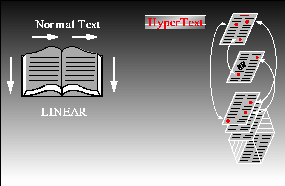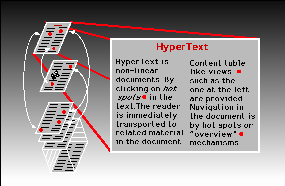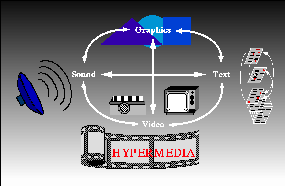![]() Reference: Chapter 1, 2 of Steinmetz and Nahrstedt
Reference: Chapter 1, 2 of Steinmetz and Nahrstedt
History of Multimedia Systems
Hypermedia/Multimedia
Overview of Multimedia Software Tools
Newspaper was perhaps the first mass communication medium, which used mostly text, graphics, and images.
In 1895, Gugliemo Marconi sent his first wireless radio transmission at Pontecchio, Italy. A few years later (in 1901) he detected radio waves beamed across the Atlantic. Initially invented for telegraph, radio is now a major medium for audio broadcasting.
Television was the new media for the 20th century. It brings the video and has since changed the world of mass communications.
On computers, the following are some of the important events:
1945 -
Vannevar Bush (1890-1974) wrote about Memex
1960s - Ted Nelson started Xanadu project
1967 -
Nicholas Negroponte formed the Architecture Machine Group at MIT
1968 -
Douglas Engelbart demonstrated NLS system at SRI
1969 - Nelson & Van Dam hypertext editor at Brown
1976 - Architecture Machine Group proposal to DARPA: Multiple Media
1985 - Negroponte, Wiesner: opened MIT Media Lab
1989 - Tim Berners-Lee proposed the
World Wide Web to CERN (European Council for Nuclear Research)
1990 - K. Hooper Woolsey, Apple Multimedia Lab, 100 people, education
1992 - The first M-Bone audio multicast on the Net
1993 - U. Illinois National Center for Supercomputing Applications: NCSA Mosaic
1994 - Jim Clark and Marc Andreesen: Netscape
1995 - JAVA for platform-independent application development.
 Vannevar Bush's 1945 article "As We May Think".
Vannevar Bush's 1945 article "As We May Think".
1.2.1 What is HyperText and HyperMedia?
Hypertext is a text which contains links to other texts.
The term was invented by Ted Nelson around 1965.
Hypertext is usually non-linear (as indicated below).
HyperMedia is not constrained to be text-based. It can include other media, e.g., graphics, images, and especially the continuous media -- sound and video. Apparently, Ted Nelson was also the first to use this term.
The World Wide Web (WWW) is the best example of hypermedia applications.



Multimedia means that computer information can be represented through audio, video, and animation in addition to traditional media (i.e., text, graphics drawings, images).
Hypermedia can be considered as one of the multimedia applications.
Examples of Multimedia Applications
-- Tools for making a complete multimedia presentation where users usually have a lot of interactive controls.
Top | CMPT 365 Home Page | CS